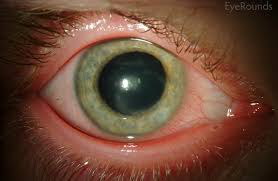Steemit greetings to you all great steemians, how was your day hope you all had a good day. I present to you my diary session. I woke up at 6:00am and took my bath 🛁 then when I finished I got dressed up and made something to eat after that I went out by 7am and took by 10am I had boiled corn and groundnut.
 .
.
Thereafter, I went and finished up my assignments I had. I will love to talk on Viral Keratitis.
What is Viral Keratitis??
Viral keratitis is a common infection of the cornea and not always associated with contact lens use. The most prevalent viruses are Herpes simplex, Varicella zoster and Adenovirus. These viruses are found ubiquitously and their transmission is either through contact (Herpes simplex) or through droplets in the air (Varicella zoster and Adenovirus) and contaminated contact lenses (Adenovirus); therefore, infection is common.Viral keratitis differs from other microbial keratitis as viruses must invade host cells and utilise their host’s machinery to replicate. The immune response to viruses differs from that of bacteria, amoebae or fungi, as viruses are obligate intracellular infectious agents. In addition, although these viruses are associated with keratitis, they cause other common conditions. Herein, the host-virus relationship will be explained, as well as details of each of these viruses.
What are viruses?
Viruses are small infectious agents that replicate inside living cells (bacteria, protists, plants and animals). There is much debate as to whether they can actually be classified as living organisms as they are simply nucleic acid (either DNA or RNA) wrapped in protein and, in some cases, also lipid. However, it is estimated that their origins are with those of the first living organisms on earth and there are several hypotheses to explain their curious life style. The idea of their existence came about in late 1800s with Louis Pasteur suggesting that the causative agent of rabies was ‘smaller than a bacterium’ and therefore could not be visualised through a microscope.The invention of the Chamberland filter, which could filter particles smaller than bacteria enabled the first studies of viruses as in the 1890s Dmitri Ivanovsky used this filter to isolate and study the tobacco mosaic virus.
Diagnosis
Laboratory identification is important to understand the origin of the infectious agent, in particular for microbial keratitis as clinical presentation is similar across all types. For the diagnosis of viral keratitis, taking a swab or a scraping from an infected eye and adding it to a cell culture flask containing cultured human cells is considered the gold standard for diagnosis.Polymerase Chain Reaction (PCR) is also often used to identify specific viruses together with Giemsa stain.PCR is the amplification of specific viral DNA sequences from a corneal swab or scraping. The advantage of PCR over culture is the speed of diagnosis (two hours for PCR versus 24 hours minimum for viral in vitro culture). In addition, PCR will have to be achieved after in vitro culture in any case to identify virus and serotype.Serology and ELISA (enzyme-linked immunosorbent assay) can also be performed to identify specific antibodies to specific viruses. Diagnosis is highly successful even after a delay as viruses can be detected for long periods of time. For example, adenovirus can be recovered from the eye and throat for as long as 14 days after the onset of clinical symptoms.
Treatment and Management
Most cases of viral keratitis resolve spontaneously within three to four weeks. However, treatment is essential to minimise severe damage to the cornea. For primary infection of HSV keratitis ganciclovir, acyclovir or trifluridine are recommended. However, antiviral resistance is emerging a vidarabine is recommended to those non-responsive to treatment. Acyclovir is also used to treat herpes zoster ophthalmicus keratitis, along with topical steroids to reduce the inflammatory response and appropriate pain relief. For adenovirus infection cidofovir is the antiviral of choice, but the patient should be treated in isolation and contact lenses discarded safely. Artificial tears and cold compresses may relieve discomfort and cycloplegic agents may help to relieve severe photophobia.
Prevention
Viral keratitis is difficult to prevent, especially if it is herpetic as it may be caused by a recurrent infection. If a patient has a history of cold sores, herpes blisters, chicken pox or shingles then it is recommended to avoid touching eyes, eyelids and surrounding areas. As for adenoviral infections, prevention of transmission is critical and patient isolation is highly recommended, followed by discarding contact lenses.
Below is an image of Herpes simplex Keratitis

Thanks for reading my post.
Bro where our own corn d 😂
Downvoting a post can decrease pending rewards and make it less visible. Common reasons:
Submit
Jesus🙆🏻♀️ E de with bingo😅
Downvoting a post can decrease pending rewards and make it less visible. Common reasons:
Submit
This is a completely new concept and I learnt much from it..✔️💯
Downvoting a post can decrease pending rewards and make it less visible. Common reasons:
Submit
I just enjoy grammar. I really wish i had some of that corn and groundnut.using your own tags is better .opinion
Downvoting a post can decrease pending rewards and make it less visible. Common reasons:
Submit